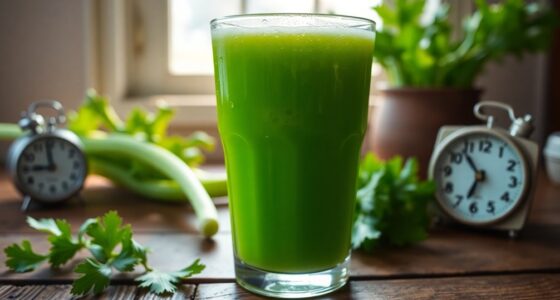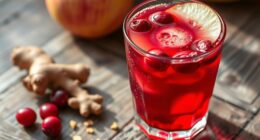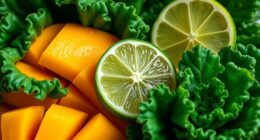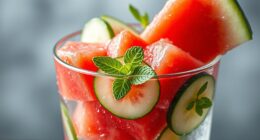To juice a pineapple without a juicer, start by selecting a ripe pineapple and cutting off the top and bottom. Peel off the skin and chop it into small chunks. Blend the chunks with a splash of water until smooth, then strain the mixture using a nut milk bag or fine sieve to extract the juice. Store it in an airtight container in the fridge for a few days. You'll soon discover more tips for maximizing your pineapple experience!
Key Takeaways
- Choose a ripe pineapple, cut off the top and bottom, and slice away the skin before chopping it into small chunks.
- Use a high-speed blender to blend the pineapple chunks until smooth, adding a bit of water or coconut water for desired consistency.
- Strain the blended mixture using a nut milk bag or fine mesh sieve placed over a bowl to extract the juice.
- Squeeze the bag or strainer to ensure all juice is extracted, yielding approximately 3 ⅓ cups of fresh pineapple juice.
- Store the juice in an airtight container in the refrigerator for up to 3-4 days, shaking before use to mix any separation.
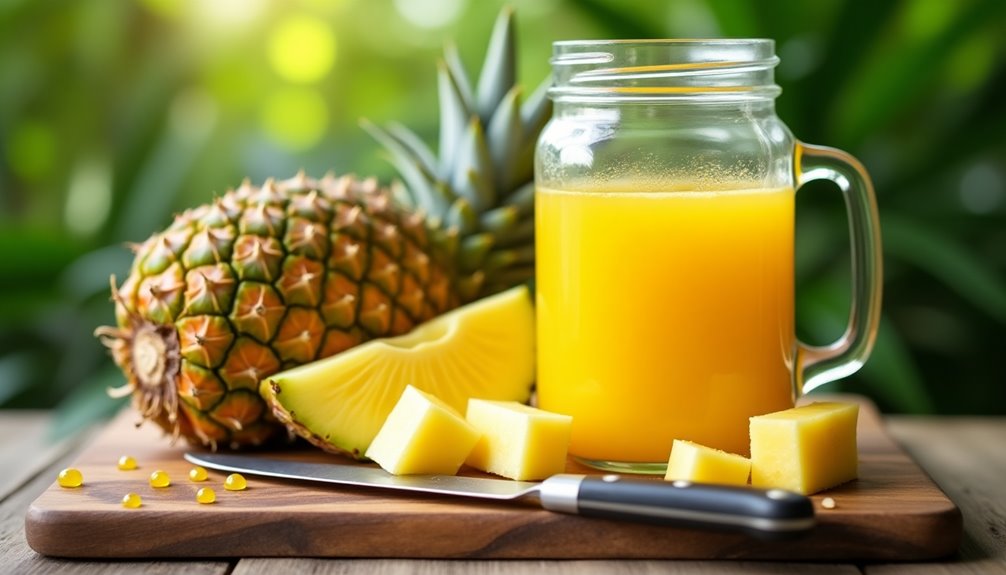
Juicing a pineapple can be a deliciously rewarding experience, especially when you realize how easy it's to do it without a juicer. You don't need fancy equipment to enjoy fresh juice; a few simple tools from your kitchen will do the trick. Let's walk through the process step by step, so you can savor that tropical goodness in no time.
Start by selecting a ripe pineapple. Look for one that's golden and fragrant. Once you've got your pineapple, it's time to peel it. Cut off the top and bottom, then slice off the skin, making sure to remove any "eyes" or brown spots. After peeling, chop the pineapple into small chunks. This makes blending easier and ensures you get the most juice out of it.
Next, grab your high-speed blender. It's the star of the show since it'll help you transform those pineapple chunks into a smooth mixture. Place the pineapple chunks into the blender, and if you want to adjust the consistency, add a small amount of water or coconut water. This addition will help the blending process, especially if your pineapple is on the firmer side. Blend everything until it's completely smooth, which should take about 30 seconds to a minute.
Now comes the fun part: straining the mixture to extract your fresh juice. You can use a nut milk bag or a fine mesh sieve for this. Place the bag or sieve over a bowl or pitcher, pour the blended pineapple mixture in, and allow the juice to strain through. You might need to squeeze the nut milk bag a bit to get every last drop out, but that’s just part of the process. The result? Approximately 3 ⅓ cups (800 ml) of delightful pineapple juice. Once you have your fresh pineapple juice, it’s best enjoyed immediately for the fullest flavor and nutritional benefits. However, if you’re wondering how long to drink pineapple juice before it begins to lose its freshness, aim to consume it within 24 to 48 hours when stored in the refrigerator. Just give it a gentle shake before pouring to re-mix any natural separation, and savor the refreshing taste of your homemade creation!
Once you've got your fresh juice, it's crucial to store it properly. Transfer it into an airtight container to keep it fresh. You can store your juice in the refrigerator for up to 3-4 days, perfect for enjoying throughout the week. Just remember to give it a little shake before you pour because separation might occur.
Don't throw away the leftover pulp! It's packed with flavor and can be used in various recipes. Toss it into smoothies for added texture, mix it into baked goods like muffins or pancakes, or even use it in savory dishes for a touch of sweetness. This way, you minimize waste while maximizing flavor in your meals.
Juicing a pineapple without a juicer isn't only simple but also a fantastic way to enjoy the vibrant taste of fresh fruit. So, grab a pineapple, follow these steps, and indulge in your homemade pineapple juice! You'll be amazed at how easy it's to enjoy this delicious treat right from your kitchen.
Frequently Asked Questions
How to Get Juice From a Pineapple Without a Juicer?
To get juice from a pineapple, start by peeling and cutting it into small chunks.
Next, toss those chunks into a high-speed blender, adding a splash of water if needed. Blend until smooth to create a pulp.
Then, strain the mixture through a fine mesh sieve or cheesecloth, squeezing out every drop of juice.
If you want extra flavor, toss in some ginger or lime juice before blending.
Enjoy your fresh juice!
Can You Juice a Pineapple in a Blender?
"Where there's a will, there's a way." Yes, you can juice a pineapple in a blender!
Start by peeling and chopping the pineapple into chunks. Add a little water to help it blend smoothly.
Blend for about 1 to 2 minutes until it's smooth. Then, strain the mixture through a fine mesh sieve or nut milk bag to separate the juice from the pulp.
Voila, you've got fresh pineapple juice ready to enjoy!
What Can I Use if I Don't Have a Juicer?
If you don't have a juicer, don't worry! You can use a high-speed blender or food processor to puree your fruit, adding a little water to help the process.
After blending, strain the mixture through a fine mesh sieve or cheese cloth to separate the juice from the pulp.
Alternatively, you can grate the fruit and press it through a cloth or cook it until soft, then mash and strain for juice.
What Does Soaking Pineapple in Water Do?
Soaking pineapple in water? Sounds counterintuitive, right? But it works wonders!
When you soak it for about 30 minutes, you help soften the fruit, making it easier to blend. Cold or room temperature water ensures it doesn't turn mushy, while extracting extra flavors and natural sugars.
This process also reduces the acidity, resulting in a sweeter, more enjoyable juice. Who knew a simple soak could unlock such delicious potential?
Conclusion
Juicing a pineapple without a juicer might seem tricky, but it's like dancing in the kitchen—once you find your rhythm, it becomes a fun experience! Picture yourself slicing through that vibrant fruit, releasing its sweet, tropical essence, just like a dancer unleashes their passion on stage. With a little creativity and effort, you'll enjoy fresh, delicious pineapple juice that's sure to brighten your day. So grab that knife and get ready to savor your homemade tropical delight!
Cindy thoroughly researches juicing trends, techniques, and recipes to provide readers with practical advice and inspiration. Her writing style is accessible, engaging, and designed to make complex concepts easy to understand. Cindy’s dedication to promoting the advantages of juicing shines through her work, empowering readers to make positive changes in their lives through the simple act of juicing.




